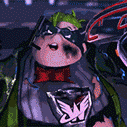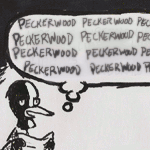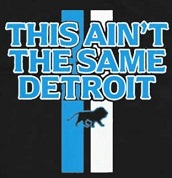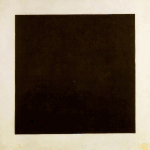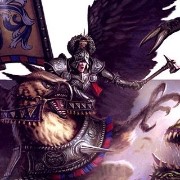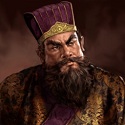|
Just wait around until the Tiger breaks down and is scuttled by its crew.
|
|
|
|

|
| # ? Jun 13, 2024 09:46 |
|
That review was mostly bullshit - not only is it true that yes, a force of 200 GIs (after dismounting from their jeeps) would be able to devise a way to disable even multiple Tiger tanks, the flaw isn't in the combat simulation so much as it is in the scenario design. The game is called The Operational Art of War. If you try to model tactical-level engagements by having company or battalion-sized formations fight it out, you're drastically increasing the possibility of edge cases causing the engine to break down. The Battle of Arracourt that comes pre-packaged with the game is an example: The Germans have several units that are composed purely of Panthers, or StuGs and whatnot. If an American CCA unit catches one of those out in the open by themselves, they'll more than often take heavy losses. This is still realistic; a combined arms unit is going to be able to run circles around heavy tanks, but the root of the problem is the designer making a scenario where the units are built like that in the first place, because the scale of the scenario is far too "zoomed-in". And this is not really a problem limited to small-scale engagements, either. If you try to make the scale of the game too big, as in Corps or Army-sized units, or even division-sized units but with a map and time-scale spanning entire campaigns, then you start drowning under too many counters and having to use lots and lots of events to cover political and industrial changes and doing fudgey/kludgey stuff like forced disbands of units into the replacement pool to simulate "injections" of Soviet mobilization. The other problem that that review tried to point out was towed anti-tank guns retreating from one hex to another, despite the fact that hexes might represent kilometers of rough terrain. But if that's unrealistic, then pretty much every other wargame ever is just as or even more unrealistic. The only difference was that TOAW actually showed the exact number of AT guns inside a unit for the first time ever and the reviewer just ran with it literally, never mind the fact that every retreating chit ever dating back to, I don't know, The Russian Campaign would have the same problem if you weren't willing to swallow the abstraction. There are definite flaws to the game, such as the temporal-element being a lot more head-math intensive than it really should be, the nature of the combat/gameplay being rather samey after a while and the quality of the game resting a whole lot on good scenario design and of course the UI, but it's really not a bad game, and I'd argue you could make this game stand-in for a whole lot of other games for a fraction of the price (War in the East!!!) because of its versatility.
|
|
|
|
Is there any link to the original review? The only one I could find doesn't seem to exist anymore (maybe it's been archived though). Edit: Yep, internet archives have it, nevermind.
|
|
|
|
Yeah this is the review, in archives And then Norm Koger posted a rebuttal as well.
|
|
|
|
Fangz posted:Just wait around until the Tiger breaks down and is scuttled by its crew. Waiting for the Tiger to get stuck and then going around it is probably the most reliable solution to the problem yes.
|
|
|
|
gradenko_2000 posted:Yeah this is the review, in archives
|
|
|
|
This passage I wanted to point out in particular:quote:Why does the game supposedly model separate equipment when it is just combined into one large value in combat resolution? What is the point, when the same results could be achieved by having a single attack strength and a single defense strength without a bunch of unnecessary separate equipment chrome? Now, I'm not a huge fan of War in the East simulating every combat down to individual squads, guns and vehicles, but this misses the point entirely. Even if an entire counter's worth of equipment was boiled down to a single attack-defense strength, it's an incredible leap ahead in terms of flexibility that you could even do that! Boardgames have struggled forever with getting their cardboard counters behave in a fine-grained fashion with regards to strength, whether it's the old half-strength/full-strength counters that you flip, or Where There is Discord's 4-step counters depending on which side is facing "up". It's a hell of a thing that you can research the TO&E of a unit at a given date and time for the battle that you're trying to simulate, plug that in, and come out with a reasonably accurate strength of a unit and all you have to tinker with are the Proficiency and Readiness values. (related article by Bruce Geryk) The rest of the review, rebuttal aside, seems to be issues with the stats of the individual units and TO&Es either being similarly wrong or just not set correctly with regards to how the engine is supposed to play, both of which have either been more-or-less corrected in the version that Matrix is currently selling or are issues caused by the scenario designer that really isn't the fault of the engine per se. EDIT: I suppose one point that I agreed with was that I'm just not used to rivers being actual hexes rather than being river hexsides. The only other game I can think of that did that was Panzer General. The scenario I'm currently playing fudges the issue by using Escarpments to simulate river hexsides, but I do wish they just put in the option of having river hexsides even if the original scenarios all use the river-as-hex model. gradenko_2000 fucked around with this message at 13:35 on Jul 14, 2014 |
|
|
|
I do find it funny that one of my favourite recent board wargames has the distinction of not having combat strength or movement allowance. I've actually seen board wargames go into the OTHER direction and try to become less granular and easier to play while still attempting to remain relatively historical accuracy. But for computer-based wargames, I do agree that the impetus should be in the other direction: more granularity, more flexibility and a statistical model not tied in with the limitations of manual computing that are required in board wargames. If you aren't going to take advantage of the strength of a platform, what is the point?
|
|
|
|
As someone who bashes TOAW often, I only do so because the game is just 99% of the way to perfection. Its a game worth getting imo.
|
|
|
|
Tekopo posted:I do find it funny that one of my favourite recent board wargames has the distinction of not having combat strength or movement allowance. I've actually seen board wargames go into the OTHER direction and try to become less granular and easier to play while still attempting to remain relatively historical accuracy. But for computer-based wargames, I do agree that the impetus should be in the other direction: more granularity, more flexibility and a statistical model not tied in with the limitations of manual computing that are required in board wargames. If you aren't going to take advantage of the strength of a platform, what is the point? One of the problems with the idea that you should throw in more complexity and stuff to consider is that you end up with games that are harder to understand as a human. There are some advantages with computers(it's easier to track discrete resources, for example), but I don't know if it's for the best to be as granular as possible. One could simulate the tactical intricacies of each squad/gun/truck in a division/battalion, but in the end is it a significant improvement over a CRT and die roll if you still do the same things with the counter?
|
|
|
|
The granularity isn't specifically there in order to improve the results from a more abstract representation of the conflict, although it does can create a much bigger range of outcomes than would be possible if you simply used a CRT (since the CRT has to define discrete resolution, something that a more granular simulation does not). The real advantage is flexibility in design and modularity of parts which just isn't present within a board wargame. If the 3rd Panzer in <board game A> is a 6-5-10, it's always going to be a 6-5-10, barring any reduced-strength flip system or dot system. It also frees designers of new scenarios from having to number crunch in order to find the relative strength of a semi-historical or even a-historical formation, because they can just add the sort of equipment they want. I think it does bring notable advantages.
|
|
|
|
The system works well in TOAW because it's supposed to be a "generic" engine so you just plug in your TO&Es, tinker with the proficiency/readiness/supply levels, add in events for chrome and you'd have a fairly plausible scenario. You might not even have to look at things like replacement pools, only unit arrivals, depending on the battle you're trying to simulate. It also works fairly well in WITE, but the rest of the game weighs it down: Command-and-control structure, support unit commitment, refit mode*, Soviet production control-but-NOT German production control, and having to manage an entire armed forces from a UI that doesn't compress information well enough and doesn't respond to user input fast enough, and the generic-ness of the model isn't utilized because so much of the game is hardcoded to be about the Eastern Front. I actually have to revise my opinion about WITE insofar as the combat system works well enough, yes it's complicated, but even if we simplified it to a plain ol' CRT there's still so much book-keeping involved that you're not really saving that much time at all.
|
|
|
|
Tekopo posted:I do find it funny that one of my favourite recent board wargames has the distinction of not having combat strength or movement allowance. I've actually seen board wargames go into the OTHER direction and try to become less granular and easier to play while still attempting to remain relatively historical accuracy. But for computer-based wargames, I do agree that the impetus should be in the other direction: more granularity, more flexibility and a statistical model not tied in with the limitations of manual computing that are required in board wargames. If you aren't going to take advantage of the strength of a platform, what is the point? I really disagree with this. The problem is that it's taking the focus of the design away from what really matters: the player experience. From the player's standpoint, the real things that matter are: 1. To what extent are future events inherently predictable? 2. To what extent am I expected to be able to predict future events so as to form strategies? 3. How much time do I need to spend diving down into TOEs and CRTs to understand my situation to the extent the designers expect me to? More complexity might leave future events inherently theoretically predictable, but it's pointless if the player cannot be reasonably expected to understand and absorb enough information to make those predictions and hence strategise appropriately on the basis of them. I think it's a more useful exercise for designers to make explicit decisions about the degree of predictability and multi-move strategising in their game, and then build the game with a view to that goal. Doing so via CRTs has the benefit of simplicity, whereas using a complicated simulational model risks creation of edge cases and more difficult tuning. I don't think it's terribly realistic either. Historically, commanders rarely had a clear view of the actual strengths of their own units, rarer still understood the actual toll a battle took on the actual combat effectiveness of the unit, and barely ever had a clear view of enemy strengths and how much damage a battle actually did to them. Side note: Idea for a game - how about a game where morale can have an impact on the information presented to the player? I mean, high morale units might overstate their capabilities, damage done to the enemy, assure you with certain victories that are anything but, and so on, while low morale units might project imaginary high strength enemy units all over the place.
|
|
|
|
Neat idea on the surface, but I don't think it's really good design to lie to your players. I think people would hate it.
|
|
|
|
e: variable recon is a thing in quite a few games, Command Ops and Combat Mission being the two most prominent in my mind. All you really know as an operational level commander when contact is made is 'there are some tanks over there, some infantry over there'. You aren't going to learn the specifics until well into the fight. This is why Ultimate General! is so good. The UI tells me instantly how many men a brigade has, so I can size up rough strength. The map is clear and vivid and once you press m has contour lines so I can see positions of strength and positions of weakness. Morale and Condition are fairly simple mechanics to grasp and have big colour coded bars I can see at a glance. Flags start flashing when a unit is close to collapse. Nowhere do I see the maths for 'how many casualties will this volley cause on average' but that doesn't matter because I can see everything I need to make the best choices I can right there on the screen. Alchenar fucked around with this message at 15:54 on Jul 14, 2014 |
|
|
|
I believe there's a myriad of ways to properly leverage the platform other than doing the same old poo poo as hex'n'counter games, except just spergin' out more numbers. Computational power of modern PCs is so often used as a crutch for bad design and convoluted, incomprehensible systems that can never be tweaked to achieve hitorical results, or eliminate Exploits. There's so many other ways to leverage the platform to make good games - such as real time and We-Go resolution, or subordinate AI so you don't have to micro tactical details when playing an operational game. Then the goon darling Unity of Command: if it were a boardgame, it would be way below complexity level of most games on the market. Yet at the same time it would be incredibly frustrating fiddly poo poo, because it turns out the eight-step system just happens to be awkward to manage with cardboard. Granularity =/= needless complexity. I fully believe that grog fondness of stuff like WITE and WITP is one of major factors holding this hobby back*. Games like Flashpoint Campaigns, Scourge of War, or Combat Mission** (which is complex as gently caress under the hood, but done in such a way that the newcomers can intuit everything on their own and never ever care about the numbers) are what I think PC designers should strive for. * Not that there's no room for such games; the're fun in their own way. I'm just disheartened their school of design is so dominant. ** CMx2 games could be just a little bit less fiddly, though.
|
|
|
|
Q_res posted:Neat idea on the surface, but I don't think it's really good design to lie to your players. I think people would hate it. Well, I think the way to make it work would to use it as a mechanic. For example, it might apply to certain generals more than others. Then the players might say, "drat that Patton! He keeps saying doing X is certain to produce a glorious victory, except I try it and my forces fall flat on their face!" Hence good strategy would be about balancing generals for their inherent bonuses, vs how their personalities interfere with the information that is being provided to you.
|
|
|
|
I do wish Ultimate General would tell me maximum morale though, I miss the old SMG 'blocks' system.
|
|
|
|
I don't think that simplicity or difficulty of prediction are tied with granularity at all, in the remotest sense. Someone could be playing a game where he can examine the OOB and still not be able to predict the outcome of a combat, entirely based on the random factors that the combat calculation uses: it is still possible for a designer to make attack/defence artificially stronger in a simulation-based wargame than it is one based on a CRT. Also, I think simplicity actually AIDS players to be able to assess the strength of his unit to an unrealistic degree, so granularity in of itself does not help or hinder the amount of information that a player has. This goes back to the idea of having a game run as a simulation of events or just making it playable for players through abstraction, and I'm actually all for both types of games to see the light (and for board wargames, I'd rather see a tendency towards simplification because otherwise manual calculations can get out of hand (see, for example, OCS in comparison to something like Campaign for North Africa). But for video games, I do feel that there is space for both types of wargames, and especially for simulations that can't be recreated using a board wargame.
|
|
|
|
As an operational level game, your main considerations (IMO) are force allocation (do I have enough units to form a cohesive front line?), force concentration (where do I intend to cause a breakthrough?), logistics (how do I maintain open supply lines to my mobile units while cutting off the enemy's?) and maneuver (how do I outflank the enemy's line?) The argument against increased complexity is that you can hit on all of these notes even if you're using bog-standard two-sided counters and a CRT. A German player isn't ever going to have enough Panzers to hit 6:1 "automatic overrun" odds on every hex that he likes, and so he has to switch to 3:1 odds attacks in some key hexes, and a die roll is arguably just as unpredictable as muddy soft factors, especially if you can generate guaranteed wins either way. And there's still a huge boon to doing it on the PC even if you're "wasting all that horsepower" because you're getting an AI, automated rules enforcement, effort-free board set-up, and so on and so on. In any case, the granularity works well in TOAW because it's supposed to cover a broad range of topics and battles and you get a lot of utility "for free", but I dislike it in WITE because there's a shitload of edge cases and special rules that they tack on on top of it that's just a hassle for the player. The refit/replacement system still has nasty bugs more than a year past release. Fangz posted:Side note: Idea for a game - how about a game where morale can have an impact on the information presented to the player? I mean, high morale units might overstate their capabilities, damage done to the enemy, assure you with certain victories that are anything but, and so on, while low morale units might project imaginary high strength enemy units all over the place. WITE had some glimmers of this idea: the Detection Level of a unit will range from 1-10. At the lowest levels you'll just know that there's a chit on that hex, and then the type and the size, and then just before you hit the full 10 the CV estimates can be wildly inaccurate (90 defensive CV when it's really more like 30 or something). And even when you actually attack there are enough unknown factors (lovely leader, bad rolls on committing support units) that the combat might still swing by a lot in one direction or another, but then there's also the high Initiative leader that can convert a badly outmatched attack into a "reconnaissance in force" where he just ends the attack immediately before any serious casualties are taken. I think there's some merit to the idea if you built around it - the attack-defense strengths of the enemy counters would depend on who's doing the detecting.
|
|
|
|
Panzer Corps is 50% off on Steam this week as part of their weekly deals. Doesn't look like it applies to the DLC, but still. Base version for $9.99. There is a package (doesn't say if it's time limited) that lets you get what looks like all the Grand Campaign stuff for $40, though. [EDIT] Ah, that pack excludes the two $15 DLCs.
|
|
|
|
I think that these old dudes making war games have really missed the forest for the trees with this accurate OOB crap. At the end of the day it is always going to be an abstraction because it is near impossible to accurately reflect the abstract on things like doctrine, morale, and leadership, so you get an over reliance on things people think they can code like whether this gun can penetrate this tank, etc. Unfortunately even these things are practically impossible to get 100 percent right because you also have things like variations in the same tank's armor, nations using different techniques to make the steel, random shot dispersement, etc. Like T 34s in reality had something like a 10mm variation in plate thickness due to poor quality construction at points, or the fact that there are 3 reports done by 3 nations on the boys AT rifle and they all give different numbers in terms of what the gun will penetrate. That the pc gives you a much better platform to have a lot of complex stuff doing on under the hood is obvious, but these guys just seem to be missing the point. Jeeps shouldn't beat Tiger tanks. WITE is a complete mess when it comes to actually modeling the eastern front. I was reading Glantz's Stalingrad trilogy while messing around with WITE and Case Blue and one of the interesting parts in there was about how after a year of combat one of most glaring changes in the way the war played out was the Wehrmacht's ability to really reduce these pockets of Soviet personnel. They just didn't have the manpower or the gas to get infantry there to block all these small Soviet units struggling to get back to their line after the initial shattering of their failed counteroffensive. This in turn leads to more combat veterans getting back and it was these officers and NCOs that really allowed the Red Army to switch from disasters like Kharkov to victories like Bagration. In WITE it is just a base percent on pocketed corps that the Red Army gets back into its manpower pool. This prevents the player of seeing the true drama of the war, but also it fails to accurately reflect the changing nature of the wehrmacht and treats these soldiers like any other pieces of equipment which is just plane wrong. Obviously a rifle doesn't improve after a few battles like a man does. It prevents the player from actually wargaming, from actually tweaking the things that really mattered in terms of how the different armies performed. The war game devs just seem too much like engineers, only concerning themselves with the hard numbers they can find and glorifying technology that really never pulled the weight. There was way more to these wars than just numbers of tanks or gallons of gas, and it just seems like the latter has been over emphasized at the expense of everything else.
|
|
|
|
For all the things wrong with WitE I'm still going to get WitW when it comes out in the fall. 
|
|
|
|
That's because there are some fundamental parts of warfare that are impossible to model, no matter the scope, granularity or complexity of the game. Also, complaining that 100 jeeps can beat 50 Tigers feels to me like kind of a stupid argument to make, because that situation wouldn't happen in real life. It's like trying to say that Total War is crappy because you can do all-infantry against all-elephant armies and the results aren't historical(Total War is crappy but for different reasons). As well as that, as the rebuttal says, there are factors beyond the jeeps 'just being jeeps' that have to be taken into account (what are the infantry have in terms of close range explosives, are they able to ambush the tank, will they disembark before contact etc etc). The unfortunate thing about any simulation of war is that it's going to be inaccurate, no matter how much you work on it, no matter how much you do to make it as accurate as possible. Making a entire division into a single counter is inaccurate. Attempting to model as at the squad level is inaccurate. Some of the factors that you describe are just hard or almost impossible to model without very heavy scripting, which detracts from the game. I also dislike the 'striving for accuracy is bad because you can't be 100% accurate' argument, especially the example given about armour thickness. So what should you do in those situations? Do nothing? Make the thickness random? The problem with wargames is that since it is impossible or nearly impossible to accurately model the soft factors of war, all you are left is the hard factors, like tanks, number of guns and fuel reserves and then you fill in the void of the soft factors through random results. The human element of wars is lost because the human elements are hard to model beyond just a general 'group level of experience'.
|
|
|
|
I was going to say something about how Case Blue in WITE still manages to capture the IRL situation fairly well simply by making it extremely difficult for the German player to form pockets in the first place, but I digress. After thinking about it a bit more, many of these issues are reminiscent of an overly large TOAW scenario. Just as the TOAW scenario has to handle equipment upgrades over the course of months and years by having a Panzer division that has lots and lots of empty equipment slots (0 / 10 Tiger tanks in June 1941) that will simply get filled out once the timed replacement pools start to kick in, or how there's an over-reliance on events ("shock modifiers") and other tricks to model changes in doctrine and tactics and proficiency, so does WITE have a very elaborate production and replacement system and rules for "National Morale" and Guards units and 1:1 combat odds up to Feb-1942 but no further. The short, 2-3 month long scenarios hold up well enough, but the game has always struggled with "how far should the Germans get in 1941?" and "how strong should the Soviet winter counter-offensive be?" and "how do we stop the Soviets from completely running away?" and "how do we not turn 1943 onwards into a purely defensive game for Germany" and so on and so forth because the game is trying to combine operational thrusts and counter-thrusts within a strategic scope. If the evolution of the Red Army feels off, it's only because we were supposed to play Blau as one scenario and Rumyantsev as another, and finally Bagration as a third, but of course that would again be a waste of all that computer horsepower when you have the entire front right there. uPen posted:For all the things wrong with WitE I'm still going to get WitW when it comes out in the fall. I've been in the beta for months and I still can't be arsed to learn all of the additional complexity they threw into the engine this time. Things were supposed to get better, not worse!
|
|
|
|
Tekopo posted:That's because there are some fundamental parts of warfare that are impossible to model, no matter the scope, granularity or complexity of the game. Also, complaining that 100 jeeps can beat 50 Tigers feels to me like kind of a stupid argument to make, because that situation wouldn't happen in real life. It's like trying to say that Total War is crappy because you can do all-infantry against all-elephant armies and the results aren't historical(Total War is crappy but for different reasons). As well as that, as the rebuttal says, there are factors beyond the jeeps 'just being jeeps' that have to be taken into account (what are the infantry have in terms of close range explosives, are they able to ambush the tank, will they disembark before contact etc etc). True in some respects but mostly bullshit imo. They put morale in all these games and the question of morale, experience, are exactly the types of things I am talking about. If they just did the lazy abstraction for equipment as they did in the morale, experience, etc departments and instead spent the time making up complex algorithms for those intangibles you would get an overall much better game because it is those things that matter most. And the jeeps thing is instructional because it did happen. When Wittmann rolled up on that Brtish convoy at Villers-Bocage how many jeeps were there? At least some. And it is entirely possible to code a game where your troops will run away at the appropriate times like they would in real life.
|
|
|
|
Is there a recent (like last decade) game with the depth/mechanics of Panzer General/Panzer Corps in a near future/sci-fi/alternate history or fantasy setting? Ever since the release of Panzer Corps I have the strong urge to play something like that again, but the WW2 setting bores me to tears.  I have played Fantasy Wars and Battle Worlds: Kronos already. If there isn't anything new I've missed I might just have to dig out my old copy of Fantasy General for the nth time.
|
|
|
|
I think there should be a game out there that has as its underlying rationale that the actual German performance in WWII was nearly optimal, and that has as a "stalemate" condition something far less than almost reaching Moscow, almost taking Stalingrad, etc. It would be interesting to see thoughts on what would be a "normal" expected war outcome with the actual outcome being deemed optimal (from the German perspective). Totaler Krieg! sort of tried this, but if I recall correctly the stalemate result still implied full capture of Poland, France, and deep penetration into the Soviet Union, with capture of Leningrad, Moscow, or Stalingrad basically being the tipping points to a German victory.
|
|
|
|
SlyFrog posted:I think there should be a game out there that has as its underlying rationale that the actual German performance in WWII was nearly optimal, and that has as a "stalemate" condition something far less than almost reaching Moscow, almost taking Stalingrad, etc. That's the theory behind WitE, except everyone always quits the moment it's clear the Germans aren't going to take Moscow.
|
|
|
|
So 'at least some' turns into '2v1 jeep versus tank battle royal'? It's not going to be some people rolling up and charging tanks in jeeps, that's not what the model is trying to portray. Unless the jeeps are modeled as literally only a single driver per jeep, then maybe you have a point. Also I've yet to see any game at the operational level that does intangible that aren't just 'approximations of morale levels/experience'. And like, where does accuracy start? War is both about intangibles AND hardware, no matter how much you attempt to reduce it. Logistics and supply are important, the type of hardware is also important and is going to have an impact on a battle. It's not an off-on switch either: it is possible to attempt to accurately model hard factors as well as soft factors, except that soft factors are much harder to model except for going 'eh, randomness'. You mentioned yourself that the modelling in games for morale/experience etc is 'lazy', but somehow also being lazy with hardware and giving a nebulous 'well, they can just make a better algorithm' is going to make a better game, somehow? You said yourself that there are intangibles that can't be accurately modeled: how complex of an algorithm do you need to have fidelity? Your algorithm is going to be always wrong because real life is not an algorithm that we can plug in and get results for. EDIT: Mind you, I do agree that complexity can be off-putting to the extreme. I'd like to see granularity but with the complexity 'under the hood', so to speak. Although that leads into the question of how to handle the predictive ability of the players in terms of results of battle. Is there any game in which there is a recon system that doesn't show the true capabilities of enemy units unless you have recon elements sent to enemy locations? Beyond modelling recon abilities organically within the units, I mean. Tekopo fucked around with this message at 20:25 on Jul 14, 2014 |
|
|
|
Alchenar posted:That's the theory behind WitE, except everyone always quits the moment it's clear the Germans aren't going to take Moscow. That might be the theory behind the tuning of WitE but if you didn't basically make up a bunch of special rules to give the Russians a chance in the winter of 1941 the Germans would make it all the way to the edge of the map with nothing to stop them. The morale system and the way the game just utterly changes mechanics at odd times is a real slight on the idea that you can make a system that makes sense. The 1941 Soviet army might as well not exist for all it does to cause any effect on the German advance in WitE.
|
|
|
|
Tarquinn posted:Is there a recent (like last decade) game with the depth/mechanics of Panzer General/Panzer Corps in a near future/sci-fi/alternate history or fantasy setting? Ever since the release of Panzer Corps I have the strong urge to play something like that again, but the WW2 setting bores me to tears. Slitherine is coming out with a Warhammer 40k version of Panzer general in the near future.
|
|
|
|
It was also already done, Warhammer 40,000: Rites of War is just re-skinned Panzer General II. I remember having the disk but not being able to get it to run any more after having updated to windows XP, so no idea if it is attainable today.
|
|
|
|
Tarquinn posted:Is there a recent (like last decade) game with the depth/mechanics of Panzer General/Panzer Corps in a near future/sci-fi/alternate history or fantasy setting? Ever since the release of Panzer Corps I have the strong urge to play something like that again, but the WW2 setting bores me to tears. Buy a used Nintendo DS and binge through all the Advance Wars games. Also check out the freeware Battle for Wesnoth, although bear in mind it can be irritating as gently caress sometimes.
|
|
|
|
The answer to the jeeps vs Tigers thing isn't yes or no, it's that the question shouldn't be asked in the first place because the counters should be composed of more than one unit. Yes, there are advantages to this granular way of doing things, but if it's just going to make players question the battle results and you're going to throw in a bunch of special boardgamey rules and you have to guesstimate morale and force proficiency anyway then just how much are you bringing to the table?
|
|
|
|
gradenko_2000 posted:The answer to the jeeps vs Tigers thing isn't yes or no, it's that the question shouldn't be asked in the first place because the counters should be composed of more than one unit.
|
|
|
|
Alchenar posted:That's the theory behind WitE, except everyone always quits the moment it's clear the Germans aren't going to take Moscow. And that is the reason I prefer to start in 1942 scenarios in war games.
|
|
|
|
This discussion reminds me of the Sid Meier quote that the computer shouldn't be having more fun playing the game than the player. Ultimately, modeling how small factors like equipment affect large things like operational battles is really, really hard; so most of the extreme detail in games like WitE ends up being no different than rolling on a CRT 99% of the time and gives really weird and implausible results due to unexpected interactions 1% of the time. Granularity is useless from a gameplay perspective (it's great at presenting a bunch of cool-looking but meaningless statistics like exact casualty counts that some people love) if your model for how granular things affect the larger scale is bad, but game designers tend to put more effort into the details than into their model. I think a game with high granularity and a large scale could be done well, but it would take a great designer and a ton of testing and tweaking - I don't think the money to support such an endeavor is there, so unless a genius designer wins the lottery and makes such a game as a labor of love, it probably won't happen.
|
|
|
|
Tekopo posted:I agree, which is why I don't have a problem with games that don't attempt granularity for the sake of good gameplay (hell, for board wargames playability is the ONLY factor I consider). I guess trying to have granularity with good gameplay is a bit of a pipe dream at the moment, though. I just feel like, if you want the juicy idea that there are little digital men shooting at each other, why not approach the problem from the other way round? Instead of trying to tune microscopic elements so that they coalesce into the desired results, have the game logic work on broad, simple terms, and then have a 'flavour engine' fill in the gaps. In other words, the RNG has already popped out the answer that the Tiger has chewed up the army of Jeeps, as expected. Now a different system takes the results of the RNG and writes up a plausible and randomised set of events that retroactively and informatively *justifies* that outcome. (The XCOM remake does something like this with the 'action shots', though that isn't very randomised ultimately) From the player's viewpoint, it's basically identical.
|
|
|
|

|
| # ? Jun 13, 2024 09:46 |
|
That could work, although that doesn't feel like a problem with granularity but really an issue with how the engine of the game really functions. Which I guess in the end it is the principal issue of granularity, because there hasn't been an effective engine that marries that and gameplay together in an effective way.
|
|
|










